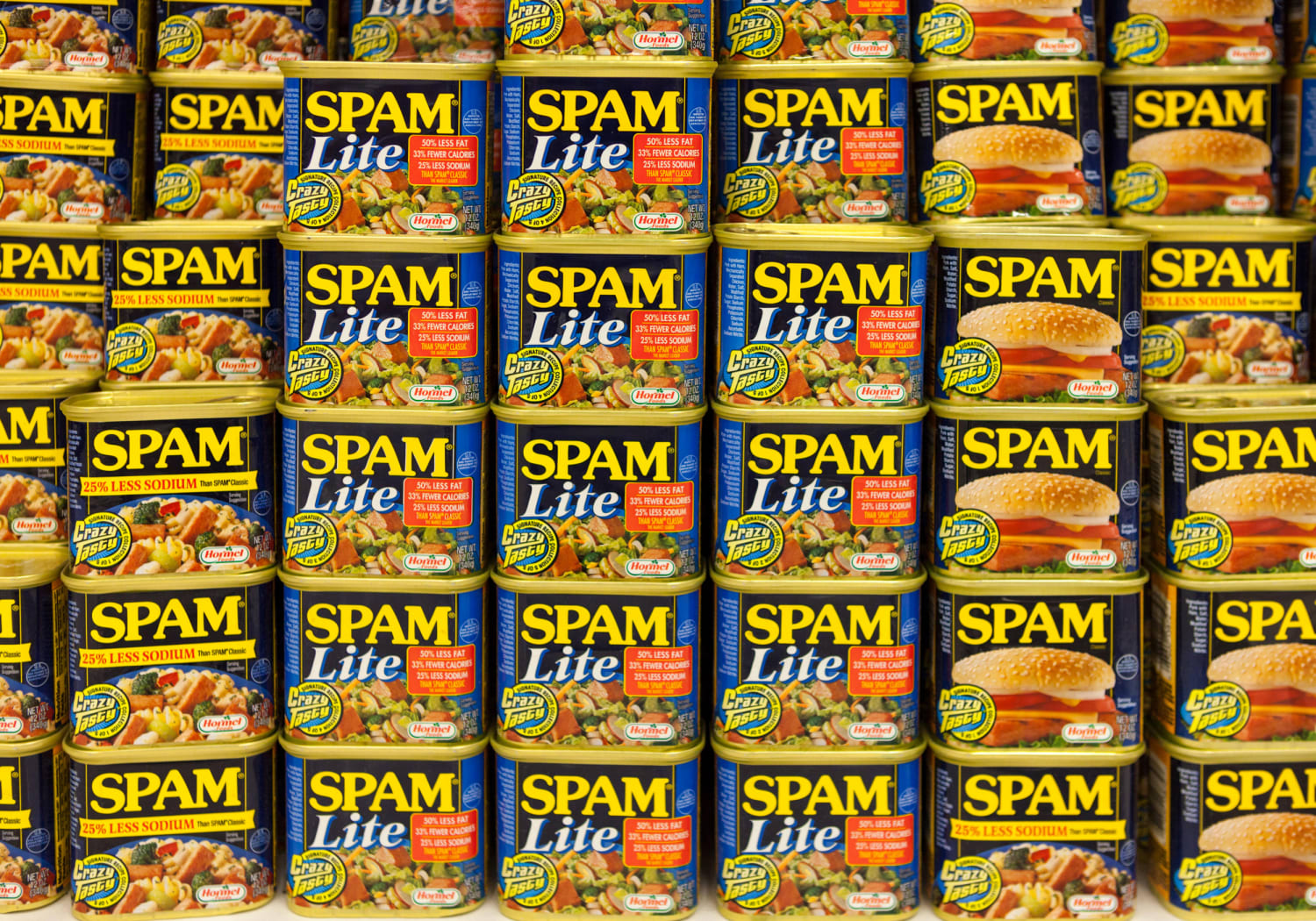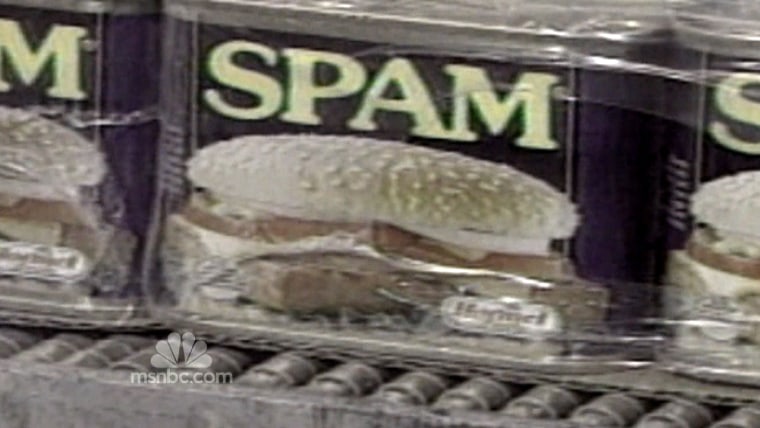In 1937, in Austin, Minnesota, Hormel Foods combined pork, water, salt, sugar and sodium nitrate, looking for a way to profit off the then-undesirable pork shoulder. The result was a nonperishable slab of pink meat, conveniently packaged in 12-ounce cans. As the story goes, Jay Hormel crossed the words “spice” and “ham” to name the invention “Spam.”
But if the pork product was invented in Minnesota, how did it come to be so uniquely celebrated in Hawaii? When I lived on the island of Oahu for two months this year, Spam was everywhere — in cafes that specialize in Spam musubi, in the refined dishes of fine-dining restaurants and the McDonald’s breakfast menu. In a phone call with TODAY Food, food biographer Carolyn Wyman recalled that while her book signings usually occur without much fanfare, she was met with a 45-minute line at the Honolulu signing of “SPAM: A Biography.” According to the SPAM website, Hawaii residents consume 7 million pounds of Spam each year.
At the same time, residents of the mainland United States tend to view the canned meat with derision. Food historian Rachel Laudan has noticed that the subject of Spam resurfaces in mainstream media at least once a year — and when it does, “People say all of the same things,” she told TODAY. “About how they wouldn’t touch it, how it’s awful … But when it comes to hot dogs, which they could say many of the same things about, they don’t. So there’s a puzzle for you.” Even the French delicacy pâté, she pointed out, often consists of pork meat and pork fat ground up together — essentially, Spam by a more palatable name.
The impulse to turn one’s nose up at Spam reflects a lack of understanding of how, exactly, Spam accrued its popularity — not just in Hawaii, but also in the Philippines, South Korea, Okinawa and other sites of U.S. colonialism throughout history. Here’s a breakdown of the significance of Spam, from the experts.
A wartime necessity
According to Laudan, Spam erupted in the Hawaiian islands during World War II. Wartime almost always demands food rationing from the civilians of entangled countries — and Hawaii was no exception. Because of the islands’ location in the middle of the Pacific, off-shore fishing became a perceived security threat subject to heavy restrictions, she said. But while Hawaii residents lost access to a major part of their diet, the large U.S. military presence there introduced a new staple food to the territory (Hawaii wasn’t recognized as a state until 1959). As troops feasted on the canned meat — its long shelf-life making it perfect for wartime conditions — its popularity spread to the people whose land those troops occupied.
“Spam, to some extent, filled in the gap (in Hawaiians’ diets),” explained Laudan. “Being able to have a can of Spam on your shelf meant that you could always make a meal.”
After all, despite its bad rep, Spam was a versatile alternative in a time when fresh meat wasn’t readily available. Hawaii residents weren’t choosing Spam over a “nice steak or a hamburger of a pork chop,” Laudan said. The other option was salted or dried meat. In comparison, Spam was “juicy and tasty,” she said. “And all you had to do was open the tab. It was great.”
Samuel Yamashita, food historian and Professor of History at Pomona College, noted that the relationship between Spam and militarism didn’t end with World War II. Even now, “Spam continues to be sent to the various parts of the U.S. empire,” he told TODAY in a phone call. Where our military bases are, Spam seems to follow.
A love affair with canned foods
While Hawaiians may have latched onto Spam out of necessity during the war, that doesn’t explain its enduring presence — why it was so readily incorporated into both the dietary and cultural landscapes of the islands. Yamashita said that the answer can be found in “the Americanization of ethnic communities.”
When people first immigrated to America from different places in Europe, Africa and Asia, they would continue to eat their own foods, he explained. But with new technological innovations in the early to mid-1800s, “there was more and more pressure among the reformers and progressives to promote canned food because it was thought to be American,” he said.
The problem was that most first-generation families couldn’t afford canned foods at the beginning of its heyday. It wasn’t until the “industrialization of food production,” which took off in the first few decades of the 1900s, that corporations could mass-produce canned food and market it nationally — a boom that included Spam, said Yamashita.
For Hawaiians, these goods were simultaneously inexpensive and regarded as a luxurious hallmark of Americanness. In this way, Spam — a food that began as “all-American” as apple pie and meatloaf, said Wyman — ironically became most associated with ethnic communities.
“In our kitchen was a cupboard right next to the door that was filled with canned goods, with Vienna sausage, with corned beef, with Spam,” Yamashita, who grew up in the Hawaiian town of Kailua, said of the significant role that canned foods played in his upbringing. “We’d have fried Spam and fried eggs and rice for breakfast. We drew on that stash of canned goods in our kitchen — and I think my family’s experience was pretty typical (of families in Hawaii).”
Celebrating Spam
The most popular manifestation of Spam is undoubtedly Spam musubi — a piece of grilled Spam placed atop a block of rice and wrapped in seaweed. But there’s some disagreement around the question of who invented it and where. One theory posits that an early version of the go-to snack food emerged in Japanese American internment camps on the mainland, where internees baked seasoned slices of Spam over rice.
But the likeliest origin story credits two women in Hawaii as Spam musubi’s creators. Apparently, Mitsuko Kaneshiro began making and selling them at a Honolulu pharmacy in the early ’80s; Barbara Funamura, a nutritionist, did the same at Kukui Grove Mall Center in 1982. No one knows which of them put the Spam, rice and seaweed combination together first, said Yamashita, so it’s fair to credit them both.
Regardless, Spam musubi is “now sold almost everywhere in the islands,” he said. “At 7-Elevens, at supermarkets, at fast food joints.”
Had it not been for the pandemic, last year would’ve been the 19th year of the Waikiki Spam Jam. The day-long celebration features around twenty restaurants, all with their own inventive Spam recipes — from Spam nachos to Spam crab cakes. Luckily, Spam lovers can mark their calendars for Oct. 23, 2021, when the festival plans to return.
This story was originally published on TODAY.com.
Follow NBC Asian America on Facebook, Twitter and Instagram.
Source: | This article originally belongs to Nbcnews.com











